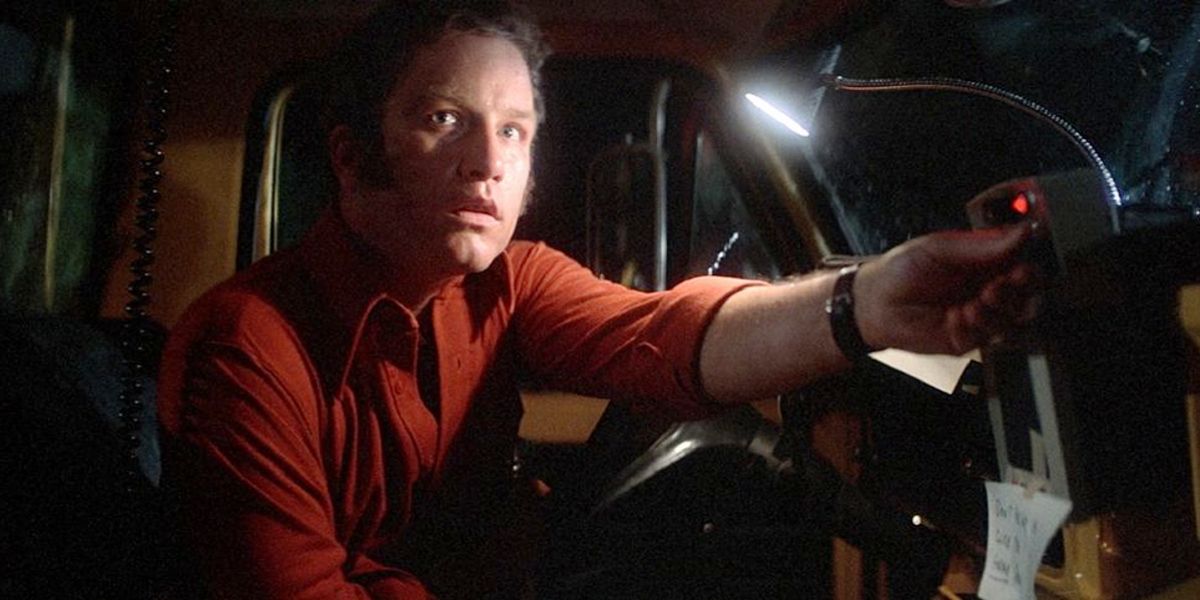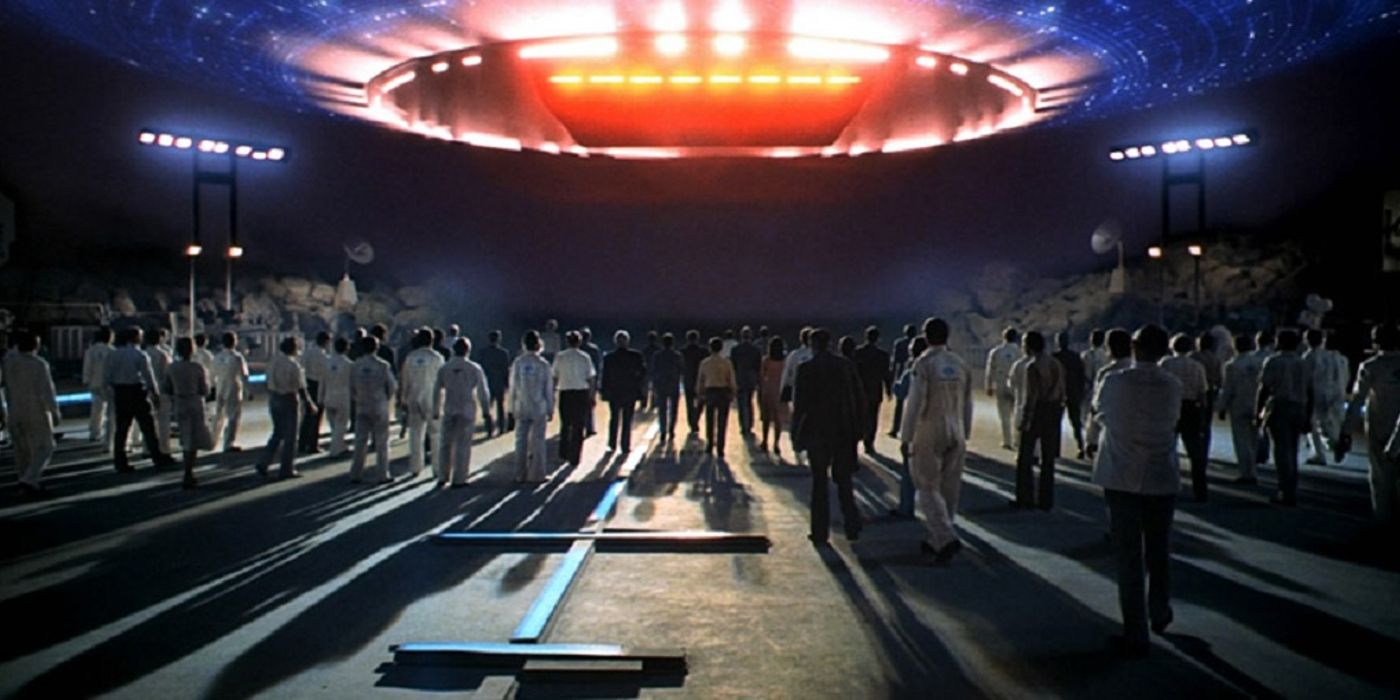When the phrase "alien invasion" is uttered, certain images tend to come to mind. Abductions, deadly lasers, ominous spacecrafts hovering in the sky, people fleeing in terror — the scenario that most people picture is an apocalyptic one. From Invasion of the Body Snatchers to Independence Day, science fiction films have often explored the idea of aliens coming to Earth as a threatening presence. After all, fear of the unknown is common among humanity, and it's not an unreasonable fear to have. However, in 1977, an upstart director named Steven Spielberg explored a different idea: What if, instead of mutual distrust and violence, humans and aliens greeted each other with mutual respect and curiosity?
Spielberg had long been intrigued by UFOs and aliens, and much of his early work incorporates these ideas. After the commercial success of Jaws, he received complete creative freedom to direct Close Encounters of the Third Kind, a project that would explore his fascination with extraterrestrial life. The plot revolves around an Indiana man named Roy (Richard Dreyfuss), whose life is changed after a "close encounter," an experience involving contact with alien life. He meets single mom Jillian (Melinda Dillon) and her three-year-old son, Barry, who have had close encounters of their own. Meanwhile, French researcher Claude Lacombe (Francois Truffaut) leads a team of scientists attempting to locate and decipher the alien signals.
Curiosity As A Driving Force
Plenty of stories have dealt with the concept of first contact, but this film handles it differently than most. In many such narratives, even when the aliens are not the monsters of the story, there's some discussion about their motives. Who are they? Why have they come to Earth, and what do they want from humanity? Do humans need to be afraid? Often, even if there is no outright violence, Earth's governments are seen preparing defenses, just in case. Close Encounters of the Third Kind, though, does not focus on this side of the story. Perhaps the military are making such preparations elsewhere, but the movie's main characters are instead attempting to solve the mystery.
From the start of the film, that mystery is what keeps the audience hooked. It is a mystery designed to intrigue, but not terrify, the audience — and it has the same effect on the characters. The imagery involved in Roy's initial close encounter is eerie, but not outright frightening: his car hovers in a beam of light, objects move rapidly, colored lights appear in the distance. The only physical harm he suffers, though, is a strange sunburn. As he, Jillian, Barry, and several others witness UFOs speeding across the sky that night, nobody is harmed or even afraid; instead, they stare on in wonder. It is that sense of wonder that drives the film, instilling in each character a desire for answers.
This pursuit of explaining the unexplained takes place from two points of view: everyman Roy, and the scientist Lacombe. By presenting these two stories alongside each other, Spielberg shows how different people are affected by the film's events. An expert with endless resources at his disposal, motivated by scientific curiosity, seeks to expand his understanding of life as we know it. Meanwhile, an average blue-collar American experiences something he once thought impossible, begins having visions of a strange land formation, and sets out on a mad dash for answers. Yet, though they are led there by different means, both end up in the same place in the film's conclusion: at the Devil's Tower in Wyoming, witnessing first contact between humans and extraterrestrials. Curiosity is not confined to the intellectual elite; rather, all who seek answers hard enough will find them eventually.
Despite the focus on curiosity and discovery, the film does deal with that fear of the unknown. The scariest it gets is a scene in Jillian and Barry's house. One evening, lights shine through the windows in their home, objects begin to move, and appliances go haywire as aliens attempt to enter the house. It's loud, it's chaotic, and Jillian is understandably terrified. Yet, unlike in movies like Poltergeist or The Changeling, other films in which unknown forces manipulate objects in a home, the audience never gets the sense that this unseen entity is trying to attack Jillian or Barry. It seems more like it's trying to get their attention — albeit in a frightening way. Still, it's a nail-biting scene, especially when it ends with Barry's disappearance. Giggling with glee, he runs off into the Indiana prairie and vanishes. Yet Barry isn't afraid of the alien visitors; instead, he's excited and eager. At three years old, his curiosity is already just as powerful as a world-class scientist's, not yet tempered by fear or caution.
What's more, as Jillian searches embarks on her search for her son, she never voices any fears for his life or doubt whether he is safe; rather, she is simply intent on reuniting with her child. At the same time, she is just as intent on reaching the place she sees in her visions, making contact with the aliens. Due to her visions, it's possible she knew that the aliens meant her son no harm — although likely subconsciously. She and Roy, though they have separate motives, wind up falling in together on their journey to the Devil's Tower, the land formation that has appeared to them. The military attempts to drive them away from the government experiment taking place — but Claude Lacombe protests on their behalf.
An Invitation To Learn From Each Other
In his plea to let Roy and Jillian seek answers alongside him, Lacombe states: "They were invited. They have more right to be here than we do." It's a succinct, beautiful description of the contact that occurs between humans and aliens throughout the film. Rather than being forcibly abducted, Barry runs off to greet new friends. Likewise, Roy and Jillian's visions lead them to a meeting place; they risk their lives multiple times to accept the invitation that has been extended to them. And when they finally make it up the mountain to the site of Lacombe's experiment, their efforts are not in vain.
The team of scientists projects the five-note musical phrase heard throughout the film, and eventually, an alien ship responds. What follows is a magnificent, interspecies symphony — as on of the scientists postulates, the visitors appear to be teaching the humans a basic vocabulary. There's no sense of hostility or even suspicion, only of wonder and fascination as the two species attempt to talk to each other. When the alien creatures disembark from their ship, they stare at the humans in awe, and everything becomes clear: just like Lacombe, Roy, Jillian, and everyone else, the visitors were motivated by their own curiosity about Earth and humanity. This is further reinforced when a few dozen humans, long thought missing, emerge from the ship, dazed but unharmed. They, too, had been invited, and had been guests aboard the ship. Barry is among those returned, and safely back in Jillian's arms, he waves a bittersweet, "Bye-bye," to his friends.
And as the little green men approach the group of humans who have volunteered to go aboard the ship — now with last-minute addition Roy among them — they surround Roy, poking and prodding him like curious children. As they lead him onboard, his delight is clear alongside theirs. He is not being taken, he has been chosen. One day, he will return unharmed, just like the other human guests. In the meantime, though, his mission is to learn as much as he can — and to let his alien hosts learn from him.
Close Encounters of the Third Kind has plenty of tension; it keeps viewers on the edges of their seats for two full hours. From the bizarre imagery of the encounters to Roy's obsessive visions, from scientists deciphering clues to Roy and Jillian being chased up the mountain by the military, there's never a dull moment. Yet none of that suspense hinges on fear of what the aliens want or what they might do; instead, it's about an eagerness to learn something new and witness a monumental moment for humanity. The final scenes of the film pay off in a glorious way — curiosity is satisfied, but a whole new adventure is about to begin.



